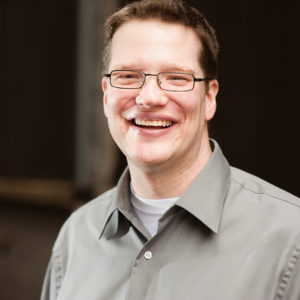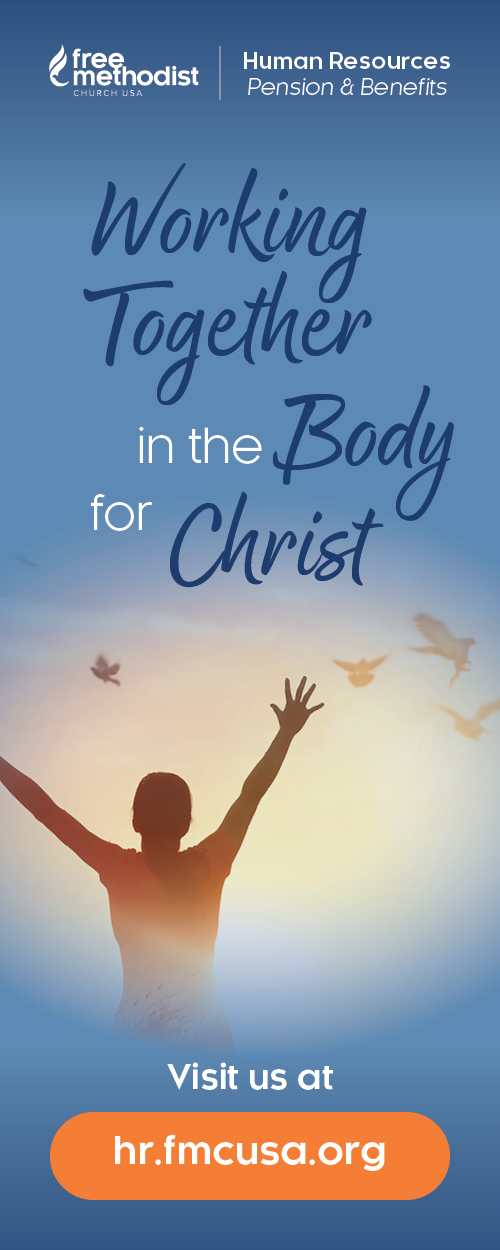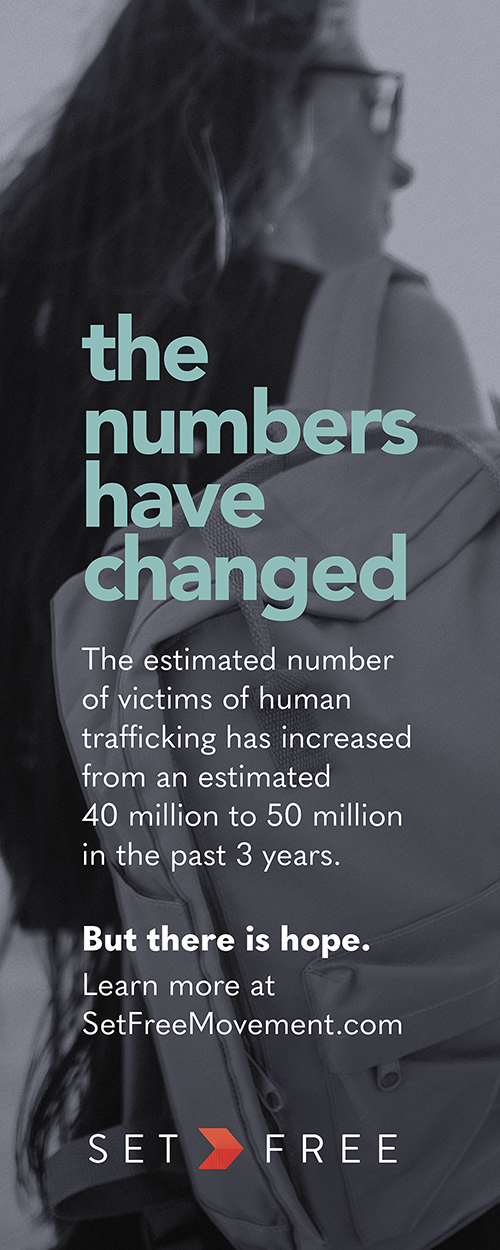
Jeff Finley
Light + Life Executive Editor
Jeff Finley is this magazine’s executive editor. He joined the Light+Life team in 2011 after a dozen years of reporting and editing for Sun-Times Media. He is a member of John Wesley Free Methodist Church where his wife, Jen, serves as the lead pastor.
by Jeff Finley
“I was born in the State of Missouri, January 7, 1859, in a little town called Springfield. I was born of slave parents. My great grandfather was brought from Africa and sold as a slave in the State of Virginia,” she continued. “When I was one month old, I, my sister, who was one and one-half years old, and my mother, who held me in her arms, were sold at the auction block to the highest bidder.”
In 1881, she met her future husband, L.P., whom she interviewed for a chapter devoted to sharing about his early life. L.P. said he was born in Texas “of a slave mother; I am told that my father was white. I know nothing of a father’s counsel, and if I am anything at all, it is because I am what I am by the grace of God and my mother’s prayers.” L.P. and Emma married in Fredonia, Kansas, in 1887. The initial marital bliss was brief.
“We were very happy for a short time. Later, my husband began to drink, not so very heavily at first,” Emma wrote. “I didn’t give it much thought, until it began to come so often — then our trouble began. When I woke up I found that he had become a drunkard.”
The couple decided to relocate to the Pacific Northwest. As detailed in Seattle Pacific University’s Response magazine, the couple “moved to Seattle following a devastating fire that leveled its downtown in 1889. They decided that here L.P., a stone mason, could make a clean start in his ongoing battle with alcoholism. Shortly after arriving in the city, Emma and L.P. became Christians.”
‘Please Sanctify Me’
The couple first attended an African Methodist Episcopal Church. Emma wrote that “the conference had moved our former pastor, because some objected to his preaching holiness,” but she pursued holiness anyway. While kneeling with friends at her church and praying “please sanctify me” one day, “the Spirit whispered softly, ‘Why do you pray longer? Can’t you believe?’” While reading a Christian book at home the next day, “all of a sudden it seemed that a streak of lightning had struck over the corner of the house, and it struck me on the top of the head, and went through my body from head to foot like liquid fire, and my whole body tingled. I tried to rise and was so weak I fell back upon the lounge [sofa] and I said, ‘What, Lord?’ and there came another dash of glory through my being and a voice inside of me said, ‘Holy.’ I tried to rise, but had not the strength and I cried, ‘O, glory! The Holy Ghost has come into my heart.’ As my strength began to return, I felt a passion, such a love for souls as I had never felt before. I saw a lost world. My heart became hot. A fire of holy, abiding love for God and souls was kindled at that hour and I felt to say with Isaiah, ‘Here am I, Lord, send me.’”
Emma organized a chapter of the Woman’s Christian Temperance Union and served as its president. She devoted herself to helping people escape poverty, crime and addiction, which led to her reputation as “the saint of Seattle’s slums.” After her AME church received a new pastor who “did not believe in the experience of entire sanctification,” and she and others “were forbidden by our pastor to testify to it,” another group of Methodists captured her attention. Emma wrote, “During our first experience in jail work, a band of Christian workers came from the Free Methodist Church at Ross, near Fremont, in this city. These meetings were conducted by a Sister Griggs, who has since died. She was assisted by several young people, from the Seminary, a Free Methodist school in the vicinity, in charge of Rev. A. Beers and his wife. This school was called at that time The Seattle Seminary, but is now known as Seattle Pacific College.”
Emma wrote about when she and L.P. first visited Seattle’s First Free Methodist Church and heard Pastor C.E. McReynolds: “We were very much impressed by the sermon that he preached at that time, and we came away feeling that we had been feasting from the Word of God. We went to our friends and told them about the sermon and invited them to go with us to the meetings. We considered him one of the best exponents of the Scriptures we had ever listened to.”
The feelings were mutual. In the introduction to Emma’s book, McReynolds wrote, “Brother and Sister Ray are held in high esteem by the Washington Conference and by all who know them. … They do not introduce fads and fancies into their revival efforts, but preach the whole gospel ‘with the Holy Ghost sent down from heaven.’”
In an article on the Black Past history website, former Seattle Pacific professor Priscilla Pope-Levison wrote that Emma and L.P. eventually became Free Methodist conference evangelists who preached throughout Washington state, and they also spent three years running “a mission in Kansas City, Missouri, for children living in poverty, providing clothes, meals, a warm place to gather in the winter, trips to the park in the summer, and weekly Sunday School.”
After first hearing about Emma, Pam Cowart — the wife of Free Methodist Bishop Keith Cowart — said she decided “to dig into her complete memoir and the fascinating story of her life. The bulk of the testimony is about her ministry; the story of her salvation and then subsequent surrender to the work of the kingdom of God in some really hard places. The first few short chapters of her memoir reveal the soil out of which she was born. She sprouted out of the soil of slavery which, to me, makes the fruit of her subsequent ministry that much sweeter. She talks so matter-of-factly in her testimony about the environment into which she was born. The stench of slavery is in her nose every day. She was born into that. Civil War battles took place so close to her home she could hear the shelling. She sang ‘Dixie’ to entertain the Confederate troops. Her family was tossed between the Confederate and Union armies. Yet this seems to be almost a footnote in the story of her life as she tells it.”
Pam added, “Her story is more filled with what the Lord has done than the trauma of her beginnings. She was not drawn to the FMC because of its abolitionist connections. She was drawn to holiness and kingdom work for the ‘least of these.’ Out of her ransomed life, she has done Harriet Tubman level work going into the darkness again and again and again to redeem those caught in the ravages of sin.”
‘Singing With the Spirit’
“Twice Sold, Twice Ransomed” has a tribute section that includes the testimony of Free Methodist Pastor Charles Witteman who said he first met Emma and L.P. 20 years earlier “in the missions and the street meetings in Seattle, Washington. They were singing and preaching the old-time religion to the crowds which were attracted by the melody and pathos of holy song. Singing with the Spirit, and with the understanding also, has been a prominent part of their ministry of the Gospel of Christ. A great many of their songs are peculiarly their own. They also possess great liberty and power in testimony, telling of their rescue from the bondage of sin. How often I have seen the men on the street listening with tears running down their grimy faces, as Emma Ray told them of a mighty Lord who is standing with outstretched arms to lift them up and save them. She is mighty in the Scriptures, too, while preaching. I remember one occasion when she was preaching (a number of preachers being present in the congregation) and urging the necessity of living religion as well as professing it, she suddenly said with great emphasis, ‘Come out into the open! Come out into the open! Practice what you preach!’”
That tribute had an impact on Pam, who reflected, “I can see her. I can hear her voice with such authority preaching in the street against the powers of hell that have bound people and taking their lives away from them. I can also see her and hear her voice with authority behind the pulpit preaching to her fellow Christians and fellow pastors to wake up and get about the work of the kingdom of God.”
Emma’s holiness preaching led her to places where few other African Americans traveled. In her autobiography, she recalled the granddaughter of a Free Methodist pastor approaching her at a camp meeting because the girl had never seen a person of color: “She looked me right in the face as I told her the story of Jesus. Then I told her about the creation and how God made everything of its own kind, and that He loved variety. I told her of the different kinds of animals, birds, and flowers, and that He also made different colored people — some white, some black, some red, and some yellow, and that He loved them all, and that it was His choice to make me black and her white. She seemed perfectly satisfied with the explanation. I wish everyone was as simple and childlike. I was glad to explain to her what I believe is the reason for my color, and if He has another purpose I can gladly say, ‘Good is the will of the Lord.’ I am perfectly satisfied with my color, and I would be almost frightened to death if I should turn white.”
For the latter half of the last century, Emma became a mostly forgotten figure in Free Methodist history, but Pam is among a growing number of modern Free Methodists who are discovering Emma’s story and sharing it with others. Pam explained, “What brings me to tears is the reality of the lineage and legacy of Emma Ray. One woman, born into slavery, but so powerfully born again into the family of God. I dream of tracing her spiritual lineage — her legacy — down through the decades and seeing how far and wide her influence has spread. She broke curses. Her blessing will be to a thousand generations.”
+

Jeff Finley
Light + Life Executive Editor
Jeff Finley is this magazine’s executive editor. He joined the Light+Life team in 2011 after a dozen years of reporting and editing for Sun-Times Media. He is a member of John Wesley Free Methodist Church where his wife, Jen, serves as the lead pastor.










My father was an FM pastor in Washington (later Oregon and California) after graduating from SPC in 1922. He had in his library the Ray’s story, and though I do not remember hearing them in person, I do remember as a child reading the book. I am 87 yrs old now, and can still recall the impact even the title had on me.
What a beautiful story of passion for holiness. When the Holy Spirit entered my life I was playing the piano and a sweet quietness overcame me…then the keys rang with joy as my heart tried to express the feeling of His presence. I wonder how Christians today feel when they truly seek holiness. Having gone to Seattle Pacific “College” I can relate to walking those streets…seeing broken lives in the mission and curbsides. The Rays certainly were the hands and feet of Jesus.